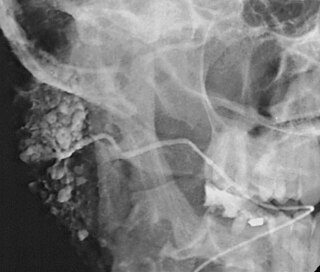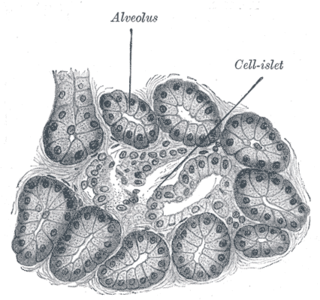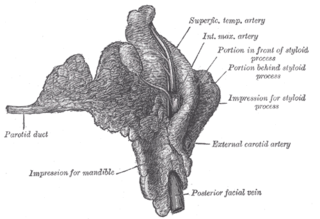This page is based on this
Wikipedia article Text is available under the
CC BY-SA 4.0 license; additional terms may apply.
Images, videos and audio are available under their respective licenses.

The parotid gland is a major salivary gland in many animals. In humans, the two parotid glands are present on either side of the mouth and in front of both ears. They are the largest of the salivary glands. Each parotid is wrapped around the mandibular ramus, and secretes serous saliva through the parotid duct into the mouth, to facilitate mastication and swallowing and to begin the digestion of starches. There are also two other types of salivary glands; they are submandibular and sublingual glands.

The paired submandibular glands are major salivary glands located beneath the floor of the mouth. They each weigh about 15 grams and contribute some 60–67% of unstimulated saliva secretion; on stimulation their contribution decreases in proportion as the parotid secretion rises to 50%.

The paired sublingual glands are major salivary glands in the mouth. They are the smallest, most diffuse, and the only unencapsulated major salivary glands. They provide only 3-5% of the total salivary volume. There are also two other types of salivary glands; they are submandibular and Parotid glands.

Sialography is the radiographic examination of the salivary glands. It usually involves the injection of a small amount of contrast medium into the salivary duct of a single gland, followed by routine X-ray projections.

Sialadenitis (sialoadenitis) is inflammation of salivary glands, usually the major ones, the most common being the parotid gland, followed by submandibular and sublingual glands. It should not be confused with sialadenosis (sialosis) which is a non-inflammatory enlargement of the major salivary glands.

Sialolithiasis, is a condition where a calcified mass or sialolith forms within a salivary gland, usually in the duct of the submandibular gland. Less commonly the parotid gland or rarely the sublingual gland or a minor salivary gland may develop salivary stones.

The intercalated duct, also called intercalary duct, is the portion of an exocrine gland leading directly from the acinus to a striated duct. The intercalated duct forms part of the intralobular duct. This duct has the thinnest epithelium of any part of the duct system, and the epithelium is usually classified as "low" simple cuboidal.

A striated duct (Pflüger's ducts ) is a gland duct which connects an intercalated duct to an interlobular duct. It is characterized by the basal infoldings of its plasma membrane, characteristic of ion-pumping activity by the numerous mitochondria. Along with the intercalated ducts, they function to modify salivary fluid by secreting HCO3− and K+ and reabsorbing Na+ and Cl− using the Na-K pump and the Cl-HCO3 pump, making the saliva hypotonic.

Salivary gland tumours or neoplasms are tumours that form in the tissues of salivary glands. The salivary glands are classified as major or minor. The major salivary glands consist of the parotid, submandibular, and sublingual glands. The minor salivary glands consist of 800-1000 small mucus-secreting glands located throughout the lining of the oral cavity.

Salivary gland diseases (SGD) are multiple and varied in cause.
A salivary gland fistula is a fistula involving a salivary gland or duct.
Salivary gland atresia is congenital blockage or absence of the orifice of a major salivary gland duct or part of the duct itself.
Ectopic salivary gland tissue which is located in sites other than the normal location is variously described as aberrant, accessory, ectopic, heterotopic or salivary gland choristoma.
Salivary duct stricture is narrowing of the duct of a major salivary gland.
Sialodochitis, is inflammation of the duct system of a salivary gland. This is compared to sialadenitis, which is inflammation of the gland parenchyma.
Ductal papilloma is a group of rare and benign papillary salivary gland tumors arising from the duct system:
Sialectasis is cystic dilation of the ducts of salivary glands. It may be caused by salivary duct strictures or stones (sialolithiasis). It can also rarely be congenital.
Salivary gland hyperplasia is hyperplasia of the terminal duct of salivary glands.












